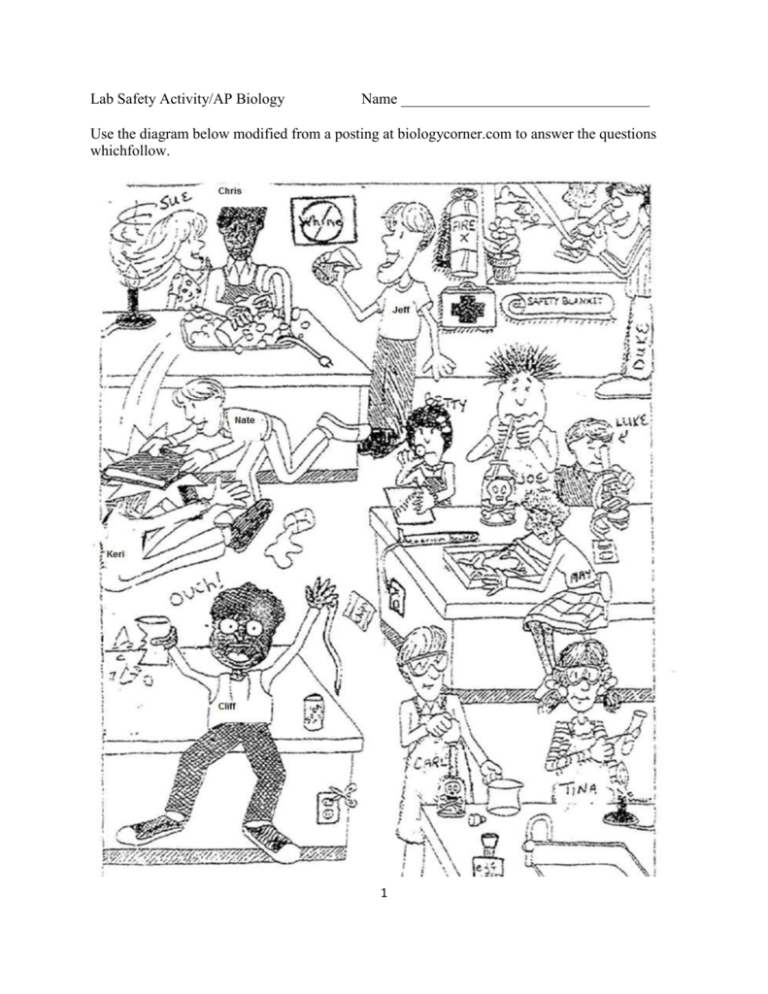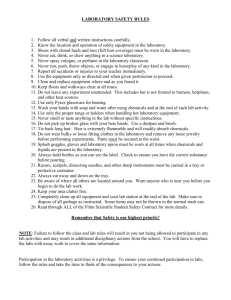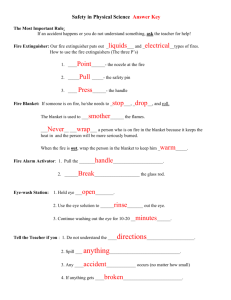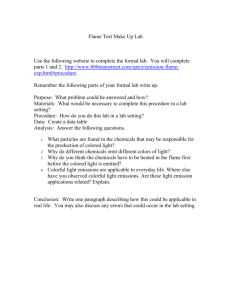Lab Safety Worksheet: AP Biology
advertisement

Lab Safety Activity/AP Biology Name _________________________________ Use the diagram below modified from a posting at biologycorner.com to answer the questions whichfollow. 1 Picture Questions: Address all questions seriously please (well except perhaps # 8 and # 10 where you may take limited creative license!) 1. List 2 unsafe activities shown in the illustration and explain why each is unsafe. 2. List 2 correct lab procedures depicted in the illustration. 3. What should Cliff do after the accident? 4. What should Sue have done to avoid an accident? 5. Compare Luke and Duke's lab techniques. Who is following the rules? 6. What are three things shown in the lab that should not be there? 7. Compare Joe and Carl's lab techniques. Who is doing it the correct way? 8. What will happen to Keri and Nate when Mr. Buckley catches them? 9. List three items in the illustration that are there for the safety of the students in the lab. 10. Who put the scissors in the electrical outlet? Why? True-False Section 1. Glass tubing can be gently and safely forced into rubber stoppers in most instances without using a lubricant. 2. A laboratory apron will protect your clothing from spills. 3. It is fine to dissect toward yourself when holding a specimen like a frog in your hand. 4. Touching heated glassware with your fingers is an excellent way to see if it is cool enough to handle. . 5. Wearing safety goggles is not necessary when doing a dissection. 6. . 7. You should never taste chemicals unless told to do so by your teacher. 8. Open test tubes should be pointed away from others and one's self when they are heated. Long hair should be tied back when working near an open flame. 9. When using electrical equipment you should keep your work area dry. . 10. Heat sources should be turned off when not in use even for short periods. 11. You should inform your teacher immediately if you spill chemicals on your skin, cut or burn yourself, or get something in your eye. 12. If chemicals get into your eyes flush them out with plenty of water immediately and tell your teacher. . 2 13. Broken, chipped, or cracked glassware can be used as long as it doesn’t leak. . 14. It is fine to reach across an open flame as long as you are careful. 15. If you are bitten or scratched by a lab animal or fellow student, you should slap the animal hard but not tell your teacher. Multiple Choice Section 1. Whom should you call in case of an emergency in the lab? (a.) instructor (b.) no one (c.) a friend (d.) cry Uncle 2. What should be immediately used if your clothing catches fire or you spill dangerous chemicals on them? (a.) Fire extinguisher (b.) Eye-wash (c.) safety shower (d.) a variety of flammables 3. What should be worn in a laboratory to decrease the chance of eye injury? (a.) eye glasses (b.) a fume hood (c.) safety glasses (d.) absolutely nothing 4. Why is it not advisable to wear contact lenses in labs involving chemicals? (a.) The contact lenses could fall out of the eye (b.) Chemical vapors could become trapped between the lenses and the eye (c.) Chemical vapor could literally react with the lenses (d.) all of the previous are reasons for not wearing contacts in labs involving chemicals 5. Which is the best procedure for operating the fire extinguisher? (a.) Remove pin from handle; Squeeze handle (b.) Aim extinguisher hose (if any) at base of fire; Squeeze handle (c.) Remove pin from handle; Aim extinguisher hose (if any) at base of fire; Squeeze handle (d.) Call the fire department in all instances as we are not qualified to use a fire extinguisher 6. Which precautions should be used with long hair? (a.) Keep long hair tied back/keep hair away from flames (b.) Dirty hair burns more easily, so hair must be shampooed twice a day (c.) It should be tied carefully in a double knot to the nearest door knob. (d.) No precautions are necessary 7. Eating and drinking in labs involving chemicals should not be permitted because (a.) you could be poisoned (b.) There would not be enough time to finish the experiment and share food with others (c.) Ms. Carr and Mr. Buckley's labs serve bad tasting snacks anyway. (d.) The lab would become quite messy with this type of activity and we never can have messes in lab 8. When should students work alone when performing a lab? (a.) always if they are responsible (b.) never (c.) sometimes if the lab needs completion (d.) when the less adapted need to be removed from the environment 3 9. What should be the very last function performed in the lab before you leave after involvement with chemicals or a dissection? (a.) Tell your favorite teacher goodbye (b.) Give your buddy a "high-five" for a job well done (c.) Set up a date with your lab partner for lunch (d.) wash your hands 10. Which is the correct procedure for smelling a chemical? (a.) Stick your nose close to the beaker and breathe deeply (b.) Pour the chemical on the desk and let all experience the smell (c.) Point vessel away from face while gently fanning vapors toward nose (d.) Smell a chemical as you would anything else as it is fun. 11. Why should no unauthorized experiments be permitted in the lab? (a.) Students lack experience in the lab (b.) Only the most select students should perform experiments (c.) You may get the experiment started and not have the chemicals you need (d.) It may take more time to perform than expected and interfere with lunch 12. When you see an unknown liquid on the bench, you should (a.) wipe it up (b.) try to identify it by using your five senses (c.) notify your teacher (d.) just leave it alone 13. Which safety procedure should a student follow during dissection? (a.) The student should wear gloves and hold the specimen in the palm of her hand while cutting the specimen open. (b.) The student should apply additional preservative to the specimen. (c.) The student should cut the specimen open while holding it under running water. (d.) The student should direct the cutting motion away from her body. Short Answer Section 1. List three safety procedures which should be followed when heating a liquid in a test tube. 2. Why should a test tube not be stoppered when heated? 3. List four safety procedures which should be handling acids or bases. 4-7. 8. List four pieces of safety equipment in the lab and its function in providing safety. Completely explain the proper procedure for evacuating from room 145 during a fire drill, fire, or other disaster. 4






